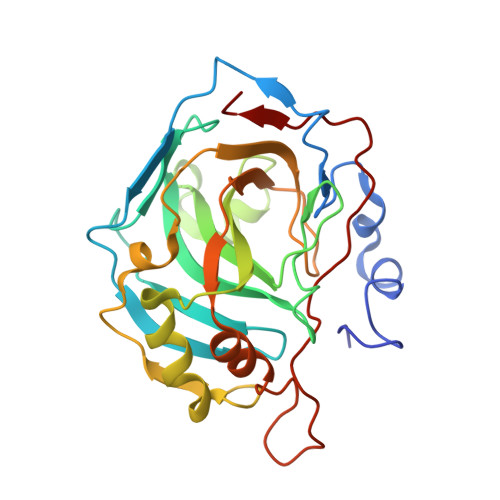Effect of donor atom identity on metal-binding pharmacophore coordination.
Dick, B.L., Patel, A., McCammon, J.A., Cohen, S.M.(2017) J Biol Inorg Chem 22: 605-613
- PubMed: 28389830
- DOI: https://doi.org/10.1007/s00775-017-1454-3
- Primary Citation of Related Structures:
5TH4, 5THI, 5THJ, 5THN, 5TI0 - PubMed Abstract:
The inhibition and binding of three metal-binding pharmacophores (MBPs), 2-hydroxycyclohepta-2,4,6-trien-1-one (tropolone), 2-mercaptopyridine-N-oxide (1,2-HOPTO), and 2-hydroxycyclohepta-2,4,6-triene-1-thione (thiotropolone) to human carbonic anhydrase II (hCAII) and a mutant protein hCAII L198G were investigated. These MBPs displayed bidentate coordination to the active site Zn(II) metal ion, but the MBPs respond to the mutation of L198G differently, as characterized by inhibition activity assays and X-ray crystallography. The L198G mutation increases the active site volume thereby decreasing the steric pressure exerted on MBPs upon binding, allowing changes in MBP coordination to be observed. When comparing the binding mode of tropolone to thiotropolone or 1,2-HOPTO (O,O versus O,S donor sets), structural modifications of the hCAII active site were shown to have a stronger effect on MBPs with an O,O versus O,S donor set. These findings were corroborated with density functional theory (DFT) calculations of model coordination complexes. These results suggest that the MBP binding geometry is a malleable interaction, particularly for certain ligands, and that the identity of the donor atoms influences the response of the ligand to changes in the protein active site environment. Understanding underlying interactions between a MBP and a metalloenzyme active site may aid in the design and development of potent metalloenzyme inhibitors.
Organizational Affiliation:
Department of Chemistry and Biochemistry, University of California San Diego, 9500 Gilman Drive, La Jolla, CA, 92093-0358, USA.




















